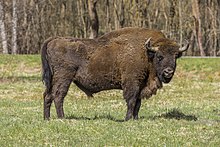
Back Wisent Afrikaans Bison bonasus AN بيسون أوروبي Arabic بيسون اوروبى ARZ Bison bonasus AST Gartukol (Bison bonasus) AVK Zubr Azerbaijani Зубр Bashkir Wisent BAR Stombros BAT-SMG
| European bison Temporal range:
| |
|---|---|

| |
| A male bison in the process of moulting | |
| Scientific classification | |
| Domain: | Eukaryota |
| Kingdom: | Animalia |
| Phylum: | Chordata |
| Class: | Mammalia |
| Order: | Artiodactyla |
| Family: | Bovidae |
| Subfamily: | Bovinae |
| Genus: | Bison |
| Species: | B. bonasus
|
| Binomial name | |
| Bison bonasus | |
| Subspecies | |
| |

| |
European bison (Bison bonasus)
| |

| |
| Range of B. bonasus (Compiled by: IUCN (International Union for Conservation of Nature) 2020) Resident
| |
| Synonyms | |
|
Bos bonasus Linnaeus, 1758 | |
The European bison (pl.: bison) (Bison bonasus) or the European wood bison, also known as the wisent[a] (/ˈviːzənt/ or /ˈwiːzənt/), the zubr[b] (/ˈzuːbər/), or sometimes colloquially as the European buffalo,[c] is a European species of bison. It is one of two extant species of bison, alongside the American bison. The European bison is the heaviest wild land animal in Europe, and individuals in the past may have been even larger than their modern-day descendants. During late antiquity and the Middle Ages, bison became extinct in much of Europe and Asia, surviving into the 20th century only in northern-central Europe and the northern Caucasus Mountains. During the early years of the 20th century, bison were hunted to extinction in the wild.
By the late 2010s, the species numbered several thousand and had been returned to the wild by captive breeding programmes. It is no longer in immediate danger of extinction, but remains absent from most of its historical range. It is not to be confused with the aurochs (Bos primigenius), the extinct ancestor of domestic cattle, with which it once co-existed.
Besides humans, bison have few predators. In the 19th century, there were scattered reports of wolves, lions, tigers, and bears hunting bison. In the past, especially during the Middle Ages, humans commonly killed bison for their hide and meat. They used their horns to make drinking horns.
European bison were hunted to extinction in the wild in the early 20th century, with the last wild animals of the B. b. bonasus subspecies being shot in the Białowieża Forest (on today's Belarus–Poland border) in 1921. The last of the Caucasian wisent subspecies (B. b. caucasicus) was shot in the northwestern Caucasus in 1927.[4] The Carpathian wisent (B. b. hungarorum) had been hunted to extinction by 1852.
The Białowieża or lowland European bison was kept alive in captivity, and has since been reintroduced into several countries in Europe. In 1996, the International Union for Conservation of Nature classified the European bison as an endangered species, no longer extinct in the wild. Its status has improved since then, changing to vulnerable and later to near-threatened.
European bison were first scientifically described by Carl Linnaeus in 1758. Some later descriptions treat the European bison as conspecific with the American bison. Three subspecies of the European bison existed in the recent past, but only one, the nominate subspecies (B. b. bonasus), survives today. The ancestry and relationships of the wisent to fossil bison species remain controversial and disputed.
The European bison is one of the national animals of Poland and Belarus.[5][6]
- ^ Plumb, G.; Kowalczyk, R.; Hernandez-Blanco, J.A. (2020). "Bison bonasus". IUCN Red List of Threatened Species. 2020: e.T2814A45156279. doi:10.2305/IUCN.UK.2020-3.RLTS.T2814A45156279.en. Retrieved 19 November 2021.
- ^ Helterbran, Valeri R. (2007). Why Flamingos Are Pink ...and 250 Other Things You Should Know. Taylor Trade Publishing. p. 28.
Bison are not related to true buffalo (Asia's water buffalo and Africa's Cape buffalo) and are only distantly related to the wisent, a European buffalo.
- ^ Conservation Note, Issue 12. U.S. Fish and Wildlife Service, Office of Information. 1962. p. 1. Archived from the original on 25 September 2021. Retrieved 24 September 2021.
No doubt you know that the American buffalo is not a buffalo, but a bison. Our buffalo is related to the European buffalo or wisent, not to the hard-working Asian buffalo or the ferocious Cape buffalo of Africa.
- ^ "70 years Wisent in the Caucasian mountains". www.lhnet.org. Archived from the original on 5 September 2015. Retrieved 13 August 2015.
- ^ "Poland". All About Bison. Archived from the original on 29 November 2020. Retrieved 30 November 2019.
- ^ Wójcik, Wojciech (director & script); Zielonka, Tomasz (lead) (2 November 2019). Las bliżej nas – Polskie żubry [The Forest Closer to Us – Polish Bison] (Documentary). Poland: Telewizja Polska.
Cite error: There are <ref group=lower-alpha> tags or {{efn}} templates on this page, but the references will not show without a {{reflist|group=lower-alpha}} template or {{notelist}} template (see the help page).
